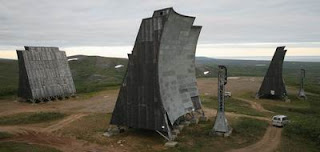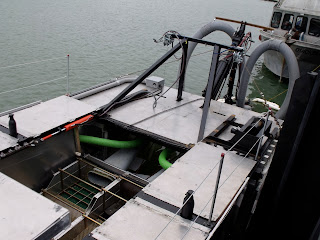First time dredgers who go to Nome are in for a rude awakening. They sooner or later find out that dredge mining for gold isn't as easy as it seems. Often times it takes at least one full dredging season for a dredger to get all equipment working as it should and to get the hang of it. Goldenrod and the team are not so different from the usual newbies. There is not one true science to gold dredging (that works for all). Like it or not, there is a learning curve.
First of all, Goldenrod was originally designed and built in a barn in Shelbyville, KY (beginning in around January 2012). It was never tested in water, as there just wasn't time for it. So, she was first launched into the Bering Sea (after being reassembled in Nome) around the 10th of July, when it was immediately discovered that the front end was heavy. Therefore, part of the anchoring system on the front was removed (which corrected that problem). Then, it was realized that the dual Kubota engines that power the suction hoses were not running at the proper RPMs to drive the water pumps, thus needed regearing. The engines are now operating at around >2300 RPMs versus the original 1500-1900. Issue solved. Then, the crew was informed by the local seasoned miners that the 'miners moss' carpeting in the bottom of the sluice boxes needed to be different to catch the finer gold. So, that was replaced (and that issue resolved). In addition, the underwater lighting system did not provide enough light, making it difficult for the crew to effectively see to do their dredging work from the cab. Additional high intensity LED lights were added and is no longer an issue for the crew.
Then the weather was a constant bust for about two weeks (actually one of the wettest on record in Nome). Once the weather broke, so did the front arm. Not once, but twice. That needed repair (two times) and and is currently stronger than ever and ready to push the underwater rocks around with several thousand pounds of force.
The Lowrance enables underwater displays
with combined sidescan and down-looking imaging,
for a complete, wider and high-definition view of the
underwater world.
Current necessary changes to made on Goldenrod: The crew recently discovered that they could dredge for 20 minutes and the sluice boxes were filled to the brim, which is obviously a flawed system. While trouble shooting the sluice, seems there is a built in dam that Keene Engineering places in these boxes. It needs to be removed, as does the mesh screen (which needs replacing with a different metal). These sluice boxes were specifically ordered by our team for dredging in the Bering Sea. Turns out they may work fantastically well for river dredging, but simply require altering for mining the Bering Sea, an all together different animal.
Gold settles underneath the rocks on the seafloor, hence the need to move them. Most recently during dredging, the end section of the arm (rock ejector) was damaged while pushing heavy rocks around. When the arm pressure is applied it is causing Goldenrod to drift and change positions in the water. Idea is, find rocky area, move rocks and suction under them. The anchoring system needs some immediate attention.
Another pressing issue is getting the panoramic sonar imaging system (Lowrance, a high definition fish finder) working accurately, which will provide information regarding the seafloor topography. This information will be used in the step of prospecting for gold. Testing the area is very important, as gold isn't everywhere on the seafloor off Nome. Our team has only tested and dredged less than 1% of what we own and have access to. Idea is, drive to a possible hot spot (as indicated by the sonar system), anchor, suction for a few minutes, then test the findings. If there is gold, continue dredging there. If not, move on.
Understand this. Gold mining is a love, a passion, and an avocation. Or rather, an expensive hobby conducted outdoors that has the possibility, at times, of generating money as well as satisfaction. So if you're interested in becoming a recreational miner, do so because it fires your imagination, not your sense of greed. This has been a grand adventure thus far for my family, as opposed to an epic failure... We've come so far so fast!!!
The following are gold totals for the famed dredging operations of The Discovery Channel
Bering Sea Gold series last season:
Christine Rose The Sluicey The Clark The Wild Ranger
766 oz. / $1,302,200 44 oz. / $74,800 38 oz. / $64,600 .75 oz. / $1,200
By the way, the new season of Bering Sea Gold airs August 24th on The Discovery Channel.



























